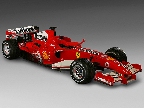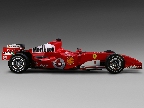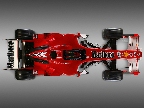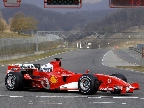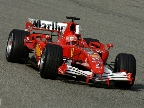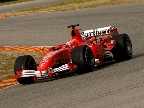Ferrari F2006 Information and Pictures
The F2006 (248 F1) is the fifty second single-seater built by Ferrari specifically to compete in the Formula 1 World Championship. The design, which bears the internal code number 057, represents Ferrari’s more exhaustive interpretation of the 2006 technical regulations.
The traditional press conference held at the presentation of the new single-seater that will compete in the Formula 1 world championship began with the engineers who have developed the car over the past months: Aldo Costa, Ross Brawn and Rory Byrne. Byrne opened and underlined how his role in the company was changing. He was progressively filling a consultancy role for all the new House of Maranello projects and, in particular, regarding the engineering of the cars.
Then came Aldo Costa, creator of the 248 F1, to reflect on Byrne's role and the characteristics of the car in detail. He declared that: "it was mainly to do with the V8 engine and we imposed a radical change from both a mechanical and aerodynamic point of view. The aerodynamics are still at a preliminary stage and will be until the first race of the season. As regards the chassis, this is totally new, above all in the centre section. We decided on this in order to optimise the weight distribution and lighten the entire structure. The same goes for the suspension, especially in the completely redesigned rear end. The transmission too is all new (though constructed from composite materials) and also the differeential. In building these two new elements in particular, we had to pay close attention to the characterisitcs of the V8. The greater vibrations generated by the engine brought more initial problems."
The gathered journalists then asked questions to which Brawn replied that "from the midway point of last season when we realised we could not challenge for the top spots, we began concentrating more on development, especially the blend of the aerodynamic configuration and the characteristics of the new V8. Despite the progress that the Bridgestone tyres have made with the reintroduction of tyre changes, we expect to see lap times that are a second or two slower than last year." In conclusion, and related again to the tyre issue, Brawn responded to newsprint journalists and emphasised how having Bridgestones this year would be an advantage as they will supply four teams. Now the Scuderia Ferrari Marlboro would be able to compare development and the progress being made with other Bridgestone teams.
After Aldo Costa, Ross Brawn and Rory Byrne came Paolo Martinelli, Formula 1 Engine Director, and Gilles Simon, head of planning and engine development, to face the journalists during the press conference to launch the new 248 F1. "It is a totally new project", began Martinelli. "It is a return to the past, as the name of the car demonstrates. We started working on this engine midway through 2004 and then tested it on the bench. Last August it made its first outing, at Fiorano, and in the autumn of 2005 we completed the V8. Now we are close to the final version. Obviously, in the course of the season we will have to cope with a very steep learning curve."
Gilles Simon's success in development was underlined: "the calculations were made long ago and even if the regulation changes were related to us rather late in the day, fundamental modifications such as the selection of the centre of gravity had already been made." "The rules outline global constraints but do allow a lot of space for projectual experimentation", continued Martinelli. "The 90° angle was our choice as was settling on the minimum weight for the non-moving parts. The real challenge, however, was lightening the weight of the moving components". "For the first time in ten years a drop in performance was recorded and this was fundamental. The change in power meant some greater investment, but, in the long run, it will be more economical. The overall output of the engine remains unchanged and so some factors were the same as on the V10."
Martinelli also revealed that there had been some dialogue between the engineers who work on road-going cars and those who concentrate on racing models. "We met the people who work on GTs and exchange opinion in analysing problems and the methods to resolve them. It was by no means a one-way communication." "We were certainly on shared ground", added Simon. "However, there are many differences, for example in our time schedules. We made a lot of input and so did they. It was a process of cross contamination."
Forza Ferrari!
Facts & Figures
| Engine |
2398cc Ferrari (Type 056), V8 |
| Fuel & Lubricant |
Shell V-Power ULG 59 |
| Lubricant |
Shell SL-0932 |
| Cylinder Block |
Die-cast aluminium 90° |
| Number of Valves |
32 |
| Distribution |
Pneumatic |
| Total Displacement |
2,398 cc |
| Fuel Feed |
Magneti Marelli digital electronic injection |
| Electronic Ignition |
Magneti Marelli static electronic ignition |
| Transmission |
Longitudinal semi-automatic sequential electronically controlled gearbox, limited-slip differential |
| Gears |
7 + reverse |
| Brakes |
Ventilated carbon-fibre discs all round |
| Suspension |
Independent, push-rod activated torsion springs |
| Chassis |
Carbon-fibre and honeycomb composite structure |
| Length |
4,545 mm |
| Width |
1,796 mm |
| Height |
959 mm |
| Front Track |
1,470 mm |
| Rear Track |
1,405 mm |
| Wheelbase |
3,050 mm |
| Weight |
600 kg with water, lubricant and driver |
| Wheels |
13" front and rear |
| Tyres |
Bridgestone |
